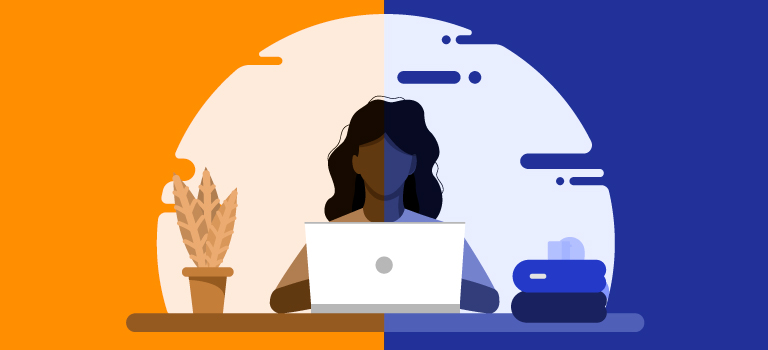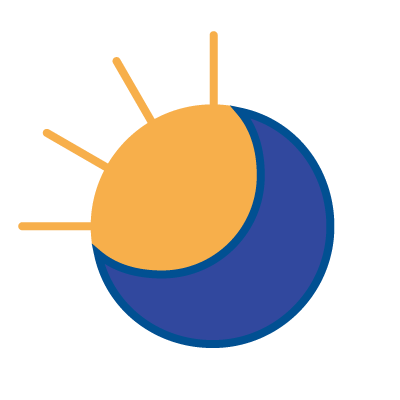The Most Productive Way to Schedule Your Day

The ongoing global pandemic has led many companies to rely on remote work for the foreseeable future. The result has become a major workforce shift that—depending on the employer—allows for more flexibility in a person’s schedule, including what hours they work, when they take breaks and what else they can accomplish during the workday while at home.
While some employers may be resistant to remote work because of minimal supervision, the Bureau of Labor Statistics (BLS) estimates that 37% of jobs can be performed entirely from home. This data may actually be an opportunity for employees to more effectively structure a work-life balance that makes sense for their personal and professional lives.
The Psychology of Productivity and Your Attention Span
Psychological researcher Larry Rosen, Ph.D., suggests that the key to productivity is fewer interruptions, as cited by the American Psychological Association’s (APA) 2017 feature on boosting productivity, but that’s not realistic for most adults working full time. When balancing a work load, family meals, children’s academics, personal fitness goals and more, the endless list of obligations makes it difficult to maintain an attention span on one thing for more than a few minutes.
One of Rosen’s strategies is to leverage the habit of taking breaks. He recommends that people reward themselves with a few minutes of checking their phones or messages after just 15 minutes of uninterrupted work.
While 15 minutes doesn’t seem like enough time to accomplish much, Rosen says, “Once you learn how to work for 15 minutes, start increasing the time before taking a technology break.”
Rosen’s research and other studies have shown that the eight-hour workday isn’t the most effective or efficient way to maintain productivity. In fact, breaking up the workday—including the onslaught of standing meetings—can drastically change a person’s energy levels and lead to more sustainable outputs in the long run.
Having a long workday with multiple large tasks can be daunting, especially if you don’t know where to begin or are prone to procrastination. Using the strategies below can help you develop time management skills that will increase your productivity over time while protecting you from burnout and overworking.
The Pomodoro Technique:
The Pomodoro Technique was created in the 1980s by Francesco Cirillo as a time management strategy designed for sustaining energy and attention. It works by creating a simple timetable for completing work so that you can set achievable goals with small increments of time.
- SET A TIMER FOR 25 MINUTES.
During this time, focus all of your attention and energy on completing the task at hand. - TAKE A SHORT BREAK WHEN YOU’RE DONE.
Use the break to rest your brain, your body and your attention. You can take a walk, have a cup of coffee or just rest your eyes for a few minutes. - EVERY FOUR ROUNDS, TAKE A LONGER BREAK.
About 20 to 30 minutes of dedicated rest time can help your cortisol levels reset and sustain your attention for long periods of time when you return to your next set of tasks.
This technique can help you discover how long it actually takes to complete a task and set more realistic expectations for the future of your time management. It can also help you stay focused by rewarding yourself with rest in between each task.
Other Strategies for Increasing Productivity
- FOCUS ON ONE TASK AT A TIME.
Giving your full attention to one task is likely to yield more accuracy and mental acuity and can help with feelings of accomplishment and satisfaction. - IDENTIFY YOUR PEAK PRODUCTIVITY HOURS.
Structure your most intellectually demanding tasks for when you’re feeling the most awake and energetic while leaving smaller managerial tasks for times when your brain is in an autopilot mode. - MINIMIZE DISTRACTIONS DURING COMPLEX TASKS.
Shut off access to other inputs like social media, television or entertainment that can pull your attention away from work. - LEVERAGE TECHNOLOGY TO SET REMINDERS FOR ROUTINES.
Using alarms or reminders can help cue your brain when it’s time to start the next task or wind down after a long day. - BLOCK OFF YOUR SCHEDULE TO AVOID CONFLICTS.
Use a calendar to keep track of meetings, calls or other obligations to protect your most productive hours. - BUNDLE SIMILAR TASKS TOGETHER.
Streamline your productivity by cutting down on the mental energy required to switch from one task to another.
Maximizing Productivity While Working from Home
While working from home presents some logistical challenges, such as social isolation, it also offers flexibility for workers who are able to schedule their day in a way that works best for their lifestyle.
Freelancers working in the gig economy have been familiar with this flexibility for years, but adults who are new to the remote work lifestyle can explore the benefits of customizing their own schedule around their personal and professional obligations.
In April of 2020, more than 50% of respondents in a Gallup survey indicated they were working from home full time because of the COVID-19 pandemic. That dropped to 33% by October as people began to return to offices, but more than two-thirds of survey respondents said they would prefer to continue working from home.
This major shift in the culture and expectations of the modern workforce may ultimately demand more flexibility and autonomy from employers.
Productivity Strategies for Working from Home
- PRIORITIZE A FEW BIG TASKS FOR EACH DAY.
Being realistic about time management can make you feel more accomplished at the end of the day when you’ve been able to check off each item on your to-do list. - KEEP A RUNNING LIST OF SMALLER, LESS IMPORTANT TASKS.
When you have a few minutes of free time throughout the day, you can make progress on this list. - RELY ON THE 52-17 RULE.
Schedule 52 minutes of work followed by 17 minutes of rest to give your brain a break from constant output. You can adjust the ratio to work better for your schedule. - TAKE BREAKS THAT INVOLVE A CHANGE OF SCENERY.
Whether that involves going for a walk, moving to a different space in your home or running a quick errand, a visual break from your workspace can help you feel more focused when you return to it.
For many people, maximizing productivity can depend on their own internal clocks—known as circadian rhythms—that regulate when the body feels the most alert and energetic. Harnessing the benefits of the circadian rhythm may take some initial self-reflection to identify when you feel the most energetic and then plan your day accordingly.
Newhouse School Online compiled research on peak productivity hours for early birds and night owls. The following timeline provides a sample of two daily schedules that may help you get the most done during your day—whether you’re an early riser or a late nighter.
How to Maximize Your Daily Schedule: For Early Birds and Night Owls
Take a personal inventory of your energy levels: What time of day do you feel the most awake? How can you leverage your sleep schedule to feel more rested each day? Whether you’re an early bird or a night owl, timelines below may help you be more productive during your nine-to-five.

EARLY BIRDS
5:30 AM: Wake up.
6 AM: Eat breakfast. The best time is within 30 minutes of waking up.
6:30 AM: Exercise. It can be easier to stick with a morning exercise routine because the timing is less likely to conflict with other responsibilities.
7:30 AM: Send emails. Emails sent between 6 a.m. and 9 a.m. are more likely to be opened and receive a response.
8 AM: Commute. On average, it takes Americans 25.4 minutes to commute to work.
8:30 AM: Prioritize your day. Make a list of the things you want to accomplish during the day.
9 AM: Work on the most difficult item on your to-do list. The morning is when you are most alert and can focus best.
10 AM: Take a coffee break. Aim for midmorning to optimize productivity. Coffee is most effective between 9 a.m. and 10:30 a.m. when cortisol (a natural hormone that regulates energy) levels are lower
10:30 AM: Schedule an interview. Avoid lunchtime and the last hours of the day because interviewees tend to be unfairly judged later in the day.
11:45 AM: Plan the afternoon. This ensures that you can take a break for lunch and be productive immediately when you return.
Noon: Eat lunch. Take a break and get away from your work space instead of eating at your computer.
2:30 PM: Schedule meetings. This is the best time for meetings. People tend to have more time as the day wears on. One study found that this time slot on Tuesdays is the most popular.
3 PM: Eat a snack. Make sure you don’t have too long of a gap between lunch and dinner.
4 PM: Work on a physical task. Hand-eye coordination peaks in the late afternoon.
5 PM: Commute.
6 PM: Brainstorm. Creativity is at its peak when you are less alert.
6:30 PM: Eat dinner. Try to eat at least three hours before going to bed to maintain a healthy metabolism.
8 PM: Relax and pursue interests. If you have a side project or artistic hobby, the late evening is a good time for creativity as fatigue lowers inhibitions and opens you up to unusual ideas.
9:30 PM: Go to sleep. Adults should aim to get between seven and nine hours of sleep each night.
NIGHT OWLS
7 AM: Wake up.
7:30 AM: Eat breakfast. The best time is within 30 minutes of waking up.
8 AM: Send emails. Emails sent between 6 a.m. and 9 a.m. are more likely to be opened and receive a response.
8:30 AM: Commute. On average, it takes Americans 25.4 minutes to commute to work.
9 AM: Brainstorm. Creativity is at its peak when you are less alert.
10 AM: Take a coffee break. Aim for midmorning to optimize productivity. Coffee is most effective between 9 a.m. and 10:30 a.m. when cortisol (a natural hormone that regulates energy) levels are lower.
10:30 AM: Schedule an interview. Avoid lunchtime and the last hours of the day because interviewees tend to be unfairly judged later in the day.
Noon: Plan the afternoon. This ensures that you can take a break for lunch and be productive immediately when you return.
12:30 PM: Eat lunch. Take a break and get away from your work space instead of eating at your computer.
2:30 PM: Schedule meetings. This is the best time for meetings. People tend to have more time as the day wears on. One study found that this time slot on Tuesdays is the most popular.
3 PM: Take a break. Make time to refresh for 10 to 30 minutes for the rest of the afternoon.
4 PM: Work on the most difficult item on your to-do list. The afternoon is when you are most alert and can focus best.
5 PM: Make a to-do list for the next day. Focus on the things you want to accomplish tomorrow and draft important emails to be sent the next morning.
5:30 PM: Commute.
6 PM: Exercise. This is when reaction time is quickest, blood pressure and heart rate are lowest, and body temperature is almost at its peak. Be sure to eat a snack before the workout if you haven’t eaten since lunch.
8:30 PM: Eat dinner. Try to eat at least three hours before going to bed to maintain a healthy metabolism.
9:30 PM: Relax and pursue interests. If you have a side project or artistic hobby, the late evening is a good time for creativity as fatigue lowers inhibitions and opens you up to unusual ideas.
11 PM: Prepare for the next day. Pack your stuff, choose your outfit, and take out breakfast ingredients.
11:30 PM: Go to sleep. Adults should aim to get between seven and nine hours of sleep each night.


